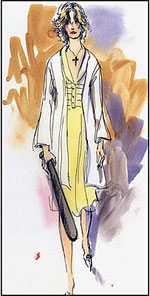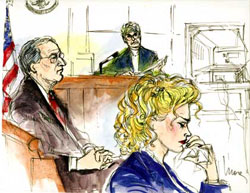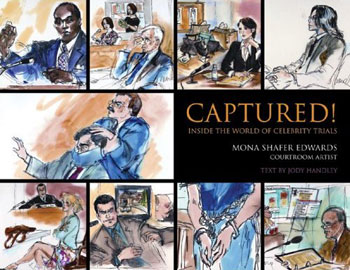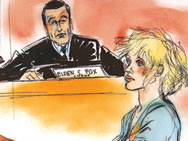| |
|

 What do 20/20, A&E Biography, ABC, CNN, Entertainment Tonight, as well as numerous publications, including Entertainment Weekly, Los Angeles Times, and Newsweek have in common? They have all featured the illustrations of Mona Shafer-Edwards, a courtroom artist. Add to her resume that she is an accomplished artist drawing fashion figures and more. What do 20/20, A&E Biography, ABC, CNN, Entertainment Tonight, as well as numerous publications, including Entertainment Weekly, Los Angeles Times, and Newsweek have in common? They have all featured the illustrations of Mona Shafer-Edwards, a courtroom artist. Add to her resume that she is an accomplished artist drawing fashion figures and more.
 A good book must tell a story, convey pertinent information, entertain and/or transport the reader to a (usually) inaccessible destination. Now, not all books can do that, however from the moment you lay eyes on the cover of Captured: Inside the World of Celebrity Trials you know you won't be disappointed. A good book must tell a story, convey pertinent information, entertain and/or transport the reader to a (usually) inaccessible destination. Now, not all books can do that, however from the moment you lay eyes on the cover of Captured: Inside the World of Celebrity Trials you know you won't be disappointed.
 Writing and sketching, both are mediums of expression, they just require different tools. Considering how Mona has directed her career, with forethought, gives writers and others excellent tips for success. Join us in an enlightening conversation with Mona Shafer-Edwards, renaissance woman. Writing and sketching, both are mediums of expression, they just require different tools. Considering how Mona has directed her career, with forethought, gives writers and others excellent tips for success. Join us in an enlightening conversation with Mona Shafer-Edwards, renaissance woman.

"My life is very diverse..."
drawing murderers one day, and
fashion figures the next...
WOW: I was quite impressed that you, as an accomplished fashion illustrator, convinced a L.A. news station art director to let you prove yourself... in the courtroom. Did you have any idea that your works would go on to achieve worldwide fame?
MONA: I never think in terms of 'worldwide fame'... I love to work, and must admit that I get a kick out of seeing my work in foreign lands. Once we were in Bali, and I saw a drawing of mine from the OJ Simpson case on TV—Now that was strange!
WOW: I'd think so...
MONA, smiling: I think Europeans really enjoy and respect my work. I've done many interviews with German, British, and French papers and I find that they're in awe of the work as ART, not just as a documentation of an event.
 Many times, I hear from friends overseas who see my work on TV and smile! Many times, I hear from friends overseas who see my work on TV and smile!
WOW: That has to be a great feeling. At the beginning when your courtroom work began receiving attention, were you given advice to do things differently? What helped you decide whether to accept or disregard suggestions?
MONA: When I started out doing courtroom art, I felt that I had to put in everything including the kitchen sink... microphones, court reporters, bailiffs, etc. The longer I worked, the more I realized that less is indeed more, and it's the main story that's important, not the architectural elements of a courtroom!
WOW: True. That's what sets your style apart from other artists. It's that West Coast flavor you've pioneered. Having learned this over time, what do you tell your students today, so they give their best—rather than trying to please everyone?
MONA: When I judge the Courtroom Art segments for the Constitutional Rights Foundation, which sponsors Junior and High School Mock Trial competitions, I tell the students to focus on the defendant, witness, judge, and attorneys, and leave out items that don't help tell the story... it will only 'muddy' the drawing, and bring less attention to the main attraction.
WOW: Actually, that is good advice for writers as well. Besides doing courtroom drawings, you are still very active with fashion illustrations; fashion sketching for advertising and bringing your viewers into the courtroom—how diverse is that?
 I realize that it all involves sketching humans and clothing, but the overall intent seems so different. One is commercial, while the other reveals truth. I realize that it all involves sketching humans and clothing, but the overall intent seems so different. One is commercial, while the other reveals truth.
MONA: My life is very diverse...drawing murderers one day, and fashion figures the next... add that to intense gardening, animal care, and all-too-frequent buying sprees at the neighborhood Trader Joe's, and my days are very different from one to the next.
 However diverse my drawing assignments are, to be truthful, I treat them the same way, and present them to the viewer in the best possible light. However diverse my drawing assignments are, to be truthful, I treat them the same way, and present them to the viewer in the best possible light.
I think that they are both commercial, because they are there to attract the viewer, and 'sell' the goods.
WOW: WOW! With what could have become distracting or disorienting, you kept your focus. Obviously, this approach has contributed to your success.
 Inline with that thought, before you realized the similarity you just described, was it an easy transition going from runway to the courtroom? Inline with that thought, before you realized the similarity you just described, was it an easy transition going from runway to the courtroom?
MONA: It was an easy transition from drawing fashion figures to stalking defendants because I think it's all drama, one way or another. Both are drawn quickly; have a focus on movement, attitude, and capture a moment.

|
"A drawing captures
the essence of
someone that a photo
can't... and it has a
more emotional tie to
the viewer." |
WOW: There's that mindset again. You're a great example for illustrators and writers...Mona, speaking of swiftness, things can happen so quickly during a trial, how do you choose what you'll include in your drawings?
MONA: I can do many drawings during a given day in a court trial. Yet, I try to limit them to 3 or 4... because I know that the TV stations aren't very generous with their time; and maybe give a minute and a half to tell the story, with my sketches given a fleeting moment or two.
 My best drawings are those that are done very quickly; and of course, I love to be able to include some drama in court in the day's work. My best drawings are those that are done very quickly; and of course, I love to be able to include some drama in court in the day's work.
WOW: And, obviously, they use your sketches to flesh out their news story as they would with pictures, if available. Is there a superiority of your drawings over pictures?
MONA: I can't talk about drawings holding 'superiority' over photographs, because one can't really compare the two.
 A drawing captures the essence of someone that a photo can't... and it has a more emotional tie to the viewer. A drawing captures the essence of someone that a photo can't... and it has a more emotional tie to the viewer.
 Photographs are cold, precise, and realistic means of reportage, but illustrations are more respectful, classic, and hold, I believe, a more storyteller feel to an event. Photographs are cold, precise, and realistic means of reportage, but illustrations are more respectful, classic, and hold, I believe, a more storyteller feel to an event.
WOW: Well said, but even more important, your words convey the love and respect for what you are able to accomplish. Your passion is a vital part of what makes your work live—from the runway to the courthouse.
 So, commemorating your work is very important on many levels. What did you hope to accomplish with your book? So, commemorating your work is very important on many levels. What did you hope to accomplish with your book?

|
Finally, I thought, "why
NOT do a book?" I have
worked for more than
25 years in covering
the most fantastic
stories of our time. |
MONA: For many years, people have repeatedly said to me, "Why don't you do a book?"
 Finally, I thought, "why NOT do a book?" I have worked for more than 25 years in covering the most fantastic stories of our time. And we never know when the camera will finally be so commonplace in a courtroom that my services will no longer be needed. So, I thought that it would be a fitting time, with the last Robert Blake trial, to compile all my favorite cases... Finally, I thought, "why NOT do a book?" I have worked for more than 25 years in covering the most fantastic stories of our time. And we never know when the camera will finally be so commonplace in a courtroom that my services will no longer be needed. So, I thought that it would be a fitting time, with the last Robert Blake trial, to compile all my favorite cases...
WOW: It would be a sad day to lose your services. As you clearly pointed out, cameras can't focus on a precise emotion in the same manner as your illustrations. Catching the expression and/or action, and removing most of the background allows the viewers' mind, and perhaps heart, to zero in on the meaning of the moment.
 This is what makes your book unique; how did you come up with the format? This is what makes your book unique; how did you come up with the format?
MONA: I wanted a format for the book that would be exciting visually.
Since most people prefer pictures to words, the first impression, the desire to see what's inside, was the main focus... The words are important, but the drawings tell the story as well, and that is important in a book such as this.

|
"I uphold the gravity of the
proceedings, and never
forget that I am there to
historically record the day's
events, without opinion or
preference." |
WOW: How would you describe the responsibility you feel regarding your courtroom drawings?
MONA: My responsibility when in court, is to respect the element in which I am a participant (albeit a quiet one!). I uphold the gravity of the proceedings, and never forget that I am there to historically record the day's events, without opinion or preference.
WOW, wincing: That last part, in my humble opinion, has to be the most difficult—on certain occasions.
 We appreciate all that you have shared; you've brought important points to mind, that we can all use to do our work better. We also got some insight into the woman behind those amazing sketches. We thank you for that. We appreciate all that you have shared; you've brought important points to mind, that we can all use to do our work better. We also got some insight into the woman behind those amazing sketches. We thank you for that.
 Before we close, we understand you live in the hills of Los Angeles with your husband, a business attorney, have two children, two golden retrievers and, is this an up-to-date number, 28 birds. Twenty-eight birds! What kind of birds? Before we close, we understand you live in the hills of Los Angeles with your husband, a business attorney, have two children, two golden retrievers and, is this an up-to-date number, 28 birds. Twenty-eight birds! What kind of birds?
MONA: I live in a Hollywood Hills canyon with coyote, hawk and deer, as natural neighbors. At home, my husband, a business and real estate attorney (no, I have never had occasion to draw him in court), share space with two huge Golden Retrievers, and 29 birds (Canaries, Cockatiels, Finches and Doves)...We have two grown children who live and work in L.A., and live not far from home!
WOW: OK, twenty-nine birds. It's easy to see that your personal life is as full of dynamism as your drawings.
 Mona, each of us remembers various sketches from TV and the newspapers that we associate with your work; may we have permission to include a few of your works, so we may more fully appreciate your wide range of talents? Mona, each of us remembers various sketches from TV and the newspapers that we associate with your work; may we have permission to include a few of your works, so we may more fully appreciate your wide range of talents?
MONA: You have my permission to use my artwork that is court-related. The posters (the Cowgirls, French Girls, and Fashion Posters) would be included with permission from WinnDevon.
WOW's closing comment: We're sorry we were unable to secure their permission before our deadline. But, certainly what we have included is a wonderful sample of your talent. Your work ethic and focus gives all pause for thought. Thank you again for letting us see in your example, that we don't want to curtail our creativity or its expression, in our work or our lives. We'll be keeping our eyes open to catch more of your works.
Here are a couple of great links:
NPR Listen to (another) interview of Mona
See the range of her works:
Neither courtroom nor fashion, but you'll love Lark by Mona |